Are you ready to embark on a culinary adventure and learn how to make the mouthwatering Soon Kueh in the comfort of your own kitchen? This delectable Asian treat, which hails from the vibrant Peranakan cuisine, is a must-try for any food enthusiast. Soon Kueh, a traditional dumpling that originated in Nyonya cuisine, is known for its soft and chewy texture and flavorful filling. Join me as I guide you through the step-by-step process of creating this delightful dish, from making the perfect dough to constructing the mouthwatering filling. Get ready to tantalize your taste buds and impress your loved ones with your culinary skills!
- Soon Kueh is a delicious Asian treat that is a part of Peranakan cuisine.
- It is a traditional dumpling with a soft and chewy texture and a flavorful filling.
- The dough for Soon Kueh is made using a combination of rice flour and tapioca starch.
- The filling typically includes ingredients such as jicama, bamboo shoots, dried shrimp, and seasonings.
- Soon Kueh is wrapped and steamed until cooked and can be served with sweet dark soy sauce and chili sauce.
Exploring Soon Kueh – A Traditional Dumpling
Soon Kueh, a beloved treat in Nyonya cuisine, has a rich history and is renowned for its unique combination of flavors and textures. These traditional dumplings are a delight to both the eyes and the palate, making them a favorite among food enthusiasts. Made with a soft and chewy dough and filled with a flavorful mixture of shredded jicama, bamboo shoots, and other herbs and seasonings, Soon Kueh offers a delightful culinary experience that captures the essence of Nyonya cuisine.
The origins of Soon Kueh can be traced back to the Peranakan communities in Malaysia and Singapore. It is believed to have been influenced by Chinese and Indonesian culinary traditions, resulting in a dumpling that is distinctly Nyonya. The combination of ingredients and the intricate wrapping technique contribute to the dumplings’ unique taste and appearance.
To make Soon Kueh at home, it is important to pay attention to the dough and filling. The dough, made with a mixture of rice flour and tapioca starch, gives the dumplings their signature soft and chewy texture. The filling, consisting of shredded jicama, carrots, bamboo shoots, dried shrimp, and fragrant seasonings, adds a burst of flavor to each bite.
Once the dough and filling are prepared, the Soon Kueh is wrapped and steamed until cooked to perfection. The dumplings can be served as a snack or a main dish, accompanied by sweet dark soy sauce and chili sauce for dipping. The combination of the tender dumplings and the savory sauces creates a harmonious flavor profile that is truly satisfying. Whether enjoyed at home or at a bustling street food market, Soon Kueh is a delightful treat that showcases the rich culinary heritage of Nyonya cuisine.
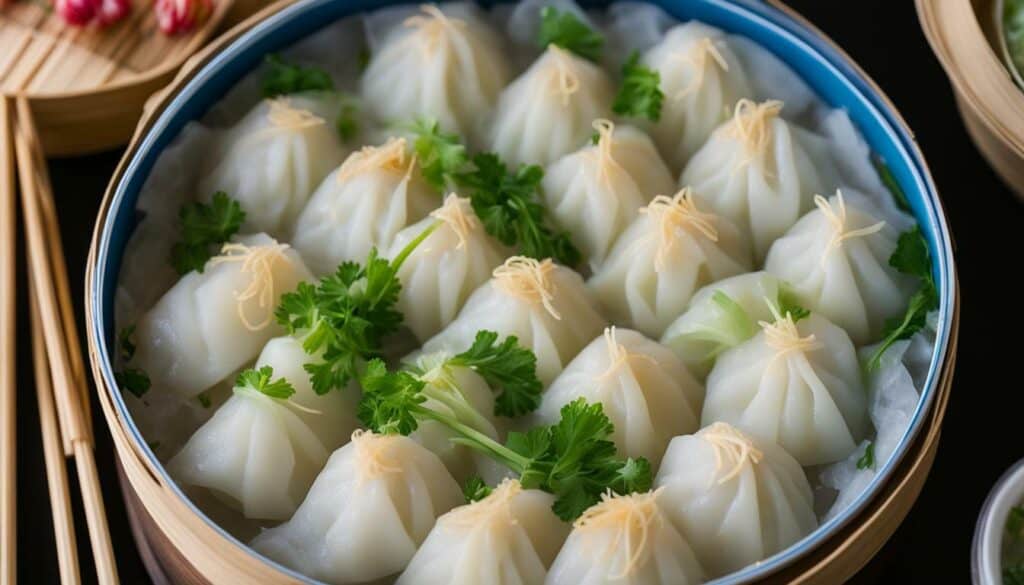
- Control over ingredients and flavors
- Freshly made and customized to personal preference
- A fun and rewarding cooking experience
- Sharing the joy of homemade Soon Kueh with family and friends
Recipe: Soon Kueh – Teochew Steamed Dumplings
| Ingredients | Instructions |
|---|---|
| For the dough: |
|
| For the filling: |
|
| Wrapping and steaming: |
|
Ingredients and Preparation for Soon Kueh
Before you embark on the Soon Kueh making journey, let’s gather all the necessary ingredients and prepare them with care. Making these glutinous rice flour dumplings requires a few key components, including the dough and the flavorful filling. Here’s a list of ingredients you’ll need:
| Dough | Filling |
|---|---|
| Glutinous rice flour | Jicama, shredded |
| Tapioca starch | Carrots, shredded |
| Water | Bamboo shoots, finely chopped |
| Salt | Dried shrimp, soaked and minced |
| Oil | Seasonings (such as soy sauce, pepper, and sugar) |
Once you have gathered all the ingredients, it’s important to prepare them properly. Start by mixing the glutinous rice flour, tapioca starch, water, salt, and oil to create a soft and pliable dough. Knead the dough until it becomes smooth and elastic. Set it aside and let it rest for about 30 minutes.
While the dough is resting, you can prepare the flavorful filling. Combine the shredded jicama, carrots, bamboo shoots, minced dried shrimp, and seasonings in a bowl. Mix everything well to ensure that the filling is evenly seasoned and packed with flavors.
With the dough and filling prepared, you’re now ready to move on to the next step of making Soon Kueh. Remember to keep the dough covered to prevent it from drying out as you work. Stay tuned for the next section, where I’ll guide you through the process of making the soft and chewy Soon Kueh dough in detail.
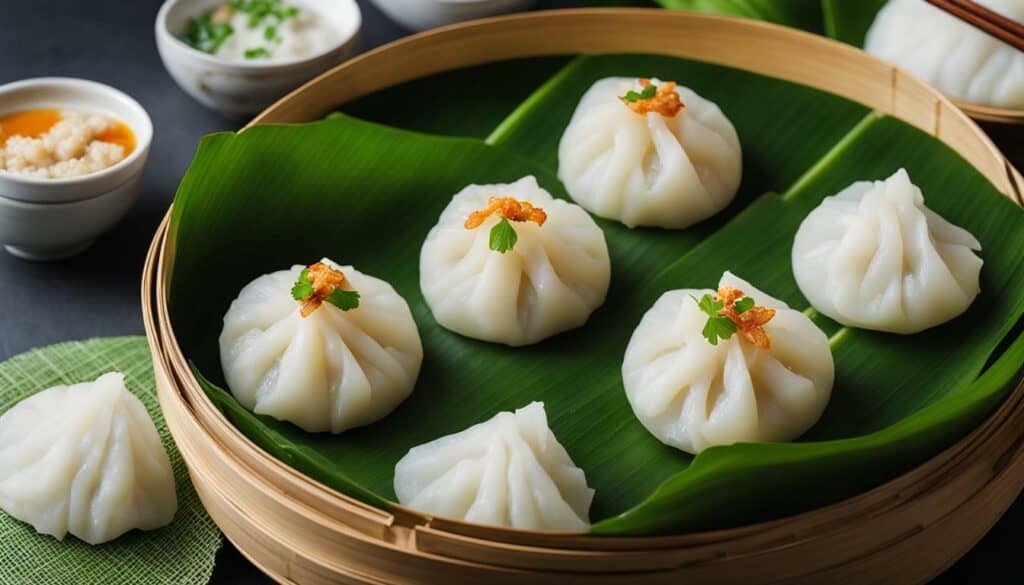
The secret to a delectable Soon Kueh lies in the softness and chewiness of its dough – let me show you how to create it effortlessly. This traditional Asian treat is made using a combination of rice flour and tapioca starch, which gives the dough its unique texture. Here’s a step-by-step guide to making the perfect Soon Kueh dough:
- In a mixing bowl, combine 1 cup of rice flour and 1/2 cup of tapioca starch.
- Add a pinch of salt to enhance the flavor of the dough.
- Gradually pour in 1 cup of boiling water while stirring the mixture with a wooden spoon.
- Continue stirring until the dough starts to come together and becomes pliable.
- Transfer the dough onto a clean surface and knead it with your hands until it becomes soft and smooth.
- If the dough feels too sticky, you can dust it with a little bit of rice flour.
- Once the dough reaches the desired consistency, cover it with a damp cloth and let it rest for 30 minutes.
Now that you have the soft and chewy Soon Kueh dough ready, you can move on to the next step, which is preparing the flavorful filling. The contrast between the tender dough and the savory filling is what makes Soon Kueh truly irresistible. Stay tuned for my next guide on creating the perfect Soon Kueh filling!
Creating the Flavorful Soon Kueh Filling
The soul of Soon Kueh resides in its flavorful filling, and I’m excited to share a recipe that will leave your taste buds craving for more. This traditional Teochew delicacy is filled with a combination of shredded jicama, bamboo shoots, and dried shrimp, resulting in a burst of savory flavors that perfectly complement the soft and chewy dumpling wrapper.
To start, gather all the ingredients for the filling. You will need:
- 1 medium jicama, peeled and shredded
- 1 cup bamboo shoots, finely chopped
- 1/2 cup dried shrimp, soaked and chopped
- 2 cloves garlic, minced
- 2 tablespoons vegetable oil
- 1 teaspoon salt
- 1/2 teaspoon white pepper
In a pan, heat the vegetable oil over medium heat. Add the minced garlic and cook until fragrant. Then, add the shredded jicama, chopped bamboo shoots, and dried shrimp. Stir-fry the mixture for about 5 minutes, until the vegetables are tender and the flavors are well combined.
Season the filling with salt and white pepper, adjusting the seasoning to taste. Remove the pan from heat and set the filling aside to cool. Once cooled, the flavorful Soon Kueh filling is ready to be wrapped in the soft and chewy dough.
Traditional Soon Kueh Filling Recipe:
| Ingredients: | Quantity: |
|---|---|
| Jicama, shredded | 1 medium |
| Bamboo shoots, finely chopped | 1 cup |
| Dried shrimp, soaked and chopped | 1/2 cup |
| Garlic, minced | 2 cloves |
| Vegetable oil | 2 tablespoons |
| Salt | 1 teaspoon |
| White pepper | 1/2 teaspoon |
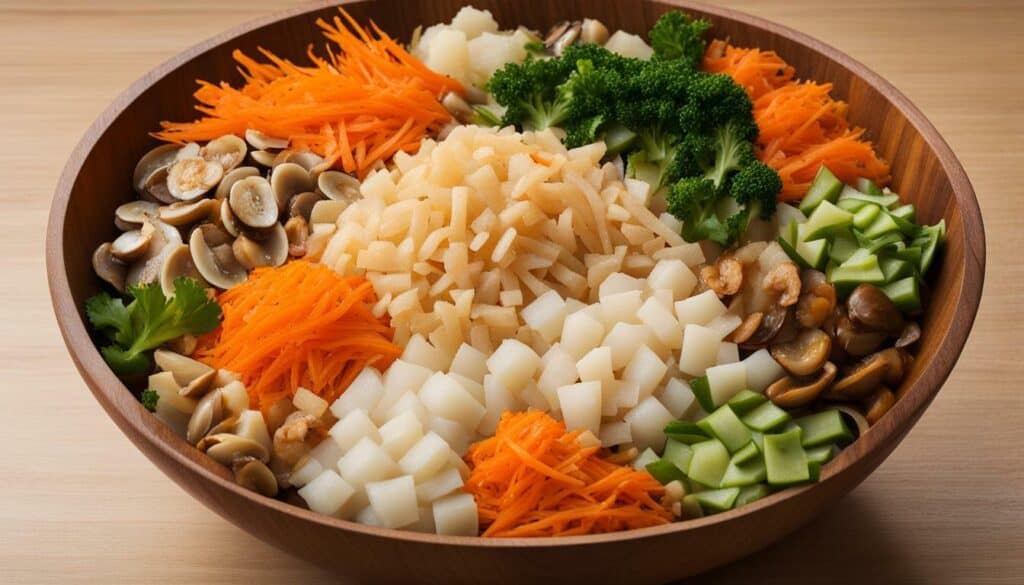
Now that you have the recipe for the flavorful Soon Kueh filling, it’s time to move on to the next section and learn how to make the soft and chewy dough that will encase the delicious filling.
Wrapping and Steaming the Soon Kueh
It’s time to get your hands a little messy as we dive into the art of wrapping and steaming the Soon Kueh to perfection. This is where the magic happens, transforming simple ingredients into delectable bite-sized dumplings filled with a burst of flavor.
First, prepare your Soon Kueh filling by combining shredded jicama, carrots, bamboo shoots, dried shrimp, and a medley of seasonings. This mixture creates a delightful combination of textures and tastes that will leave your taste buds craving for more.
Next, it’s time to wrap the Soon Kueh. Start by rolling out the dough into thin, round wrappers. Place a spoonful of the filling in the center of each wrapper, then gently fold and pleat the edges, sealing the dumpling with a neat closure. The process may seem a bit challenging at first, but with a little practice, you’ll soon be wrapping like a pro.
Now that your Soon Kueh is beautifully wrapped, it’s time to steam them to perfection. Arrange the dumplings in a steamer lined with parchment paper, making sure to leave some space between each piece. Steam for about 10-15 minutes, until the dumplings are cooked through and the wrappers have turned translucent.
Once cooked, carefully remove the Soon Kueh from the steamer and let them cool slightly before serving. The soft, chewy texture of the dumplings, combined with the flavorful filling, is a delightful experience for the senses.
Whether you enjoy them as a snack, appetizer, or part of a full meal, Soon Kueh is a versatile treat that can be enjoyed in various ways. Serve them with a dipping sauce made from sweet dark soy sauce and chili sauce to elevate the flavors even further.
Remember, practice makes perfect when it comes to Soon Kueh. So, don’t be afraid to experiment with different fillings and wrapping techniques to create your own signature dumplings. Explore the rich culinary traditions of Asia and unleash your inner chef as you embark on this delicious journey of making Soon Kueh at home.
Serving and Enhancing the Soon Kueh Experience
The Soon Kueh feast is not complete without the right accompaniments – let me guide you on serving and enhancing this culinary delight. When it comes to enjoying Soon Kueh, a harmonious balance of flavors is key. One popular choice is to pair your steamed dumplings with sweet dark soy sauce and chili sauce. The rich sweetness of the soy sauce complements the savory filling, while the chili sauce adds a delightful kick of spiciness. Together, they elevate the taste of the Soon Kueh to new heights.
As you savor each bite, you can also experiment with different presentations and garnishes to make your Soon Kueh platter visually appealing. Consider adding a sprinkle of chopped spring onions or a drizzle of sesame oil for an extra flourish. These small touches not only enhance the overall aesthetic but also add layers of flavor to your dining experience.
For those looking to explore a variety of flavors, consider serving your Soon Kueh with a side of pickled vegetables or a refreshing cucumber salad. The tangy and crunchy textures of these accompaniments provide a delightful contrast to the soft and chewy dumplings. It’s all about finding the perfect combination of flavors and textures to tantalize your taste buds.
So, the next time you indulge in Soon Kueh, don’t forget to prepare the perfect accompaniments. With a dash of sweet dark soy sauce, a dollop of chili sauce, and a creative touch in presentation, you can truly elevate your Soon Kueh experience and delight your senses.
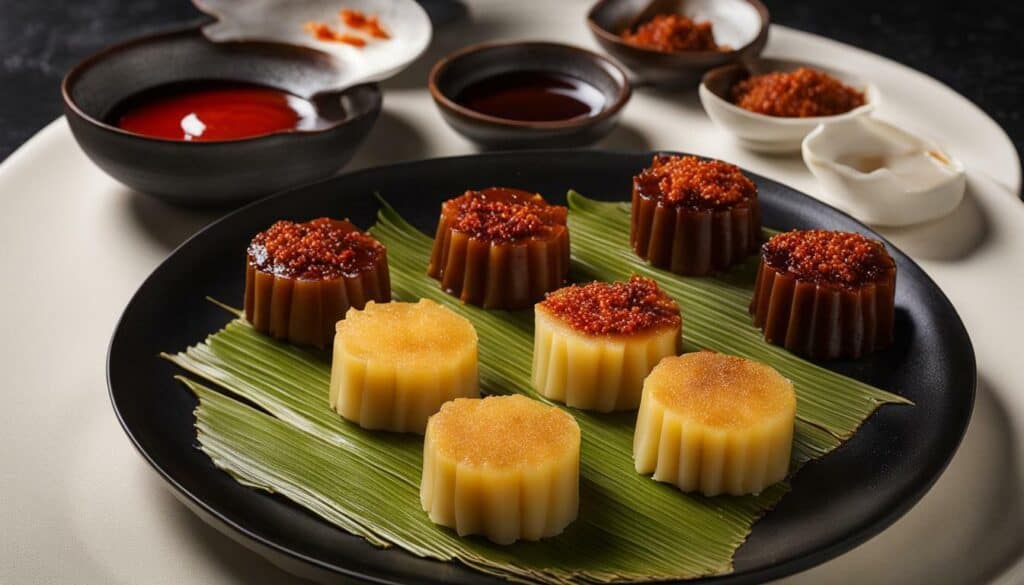
While Soon Kueh is best enjoyed freshly steamed, I will share some tips to help you store and reheat them without compromising on their deliciousness. Once you have made your batch of Soon Kueh, allow them to cool completely before storing them. This will prevent any condensation from forming and making the dumplings soggy.
To store the Soon Kueh, place them in an airtight container or wrap them tightly with plastic wrap. Make sure to separate the layers with parchment paper or plastic wrap to prevent sticking. You can store them in the refrigerator for up to 2-3 days, but remember, the sooner you consume them, the better they will taste.
When it’s time to reheat the Soon Kueh, there are a few methods you can use. One option is to steam them again, just like when you first cooked them. Simply place the dumplings in a steamer and steam for about 5-7 minutes until heated through. Alternatively, you can heat them in a microwave. Place a few dumplings on a microwave-safe plate and cover with a damp paper towel. Microwave on high for about 1-2 minutes until warmed.
| Storing Soon Kueh | Reheating Soon Kueh |
|---|---|
| – Allow the dumplings to cool completely before storing. | – Steam the dumplings for 5-7 minutes or microwave on high for 1-2 minutes. |
| – Store in an airtight container or wrap them tightly with plastic wrap. | – Place the dumplings in a steamer or on a microwave-safe plate. |
| – Separate layers with parchment paper or plastic wrap to prevent sticking. | – Cover the microwave plate with a damp paper towel. |
| – Store in the refrigerator for up to 2-3 days. | – Heat until the dumplings are warmed through. |
By following these tips, you can enjoy the delightful flavors of Soon Kueh even after they have been stored and reheated. Whether you make a big batch for a special occasion or simply want to savor your leftovers, these methods will ensure that your dumplings retain their softness and taste just as delicious as when they were first made. So go ahead and whip up some Soon Kueh, knowing that you can savor them at your own pace!
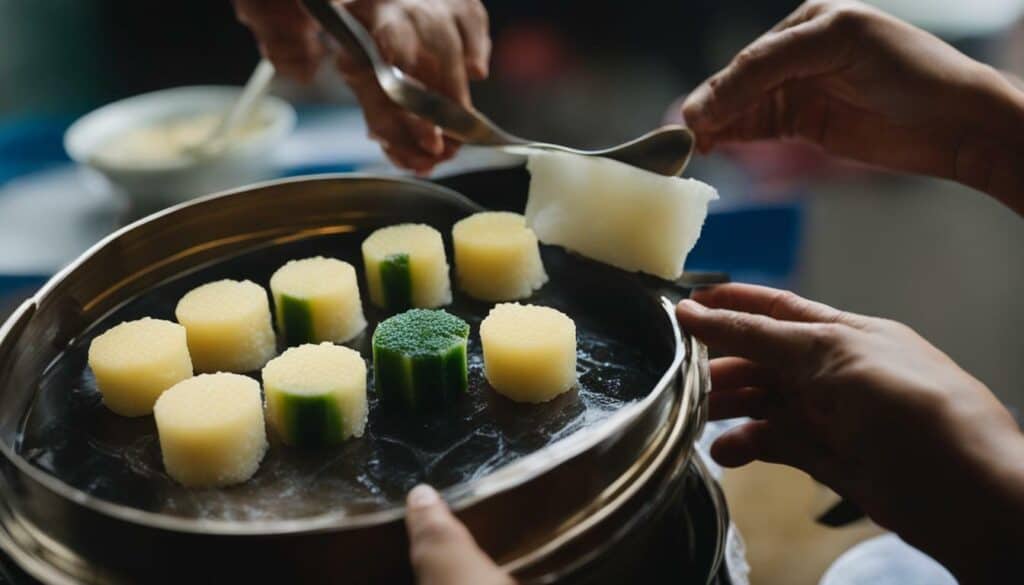
One of the great things about Soon Kueh is its versatility. While the traditional recipe calls for jicama and bamboo shoots, you can experiment with different fillings to suit your taste preferences. Try adding ingredients like carrots, mushrooms, or even minced meat for a twist on the classic recipe. The key is to ensure that the filling is well-cooked and flavorful. So don’t be afraid to get creative in the kitchen and make Soon Kueh truly your own!
The Joy of Soon Kueh – A Singaporean Delicacy
To truly appreciate the joy of Soon Kueh, it’s important to understand its place in Singapore’s food culture and the bustling world of Asian street food. This delightful dumpling is a beloved Singaporean delicacy that can be found in local markets and eateries throughout the city. Its popularity stems from its unique flavors and the distinct culinary traditions it represents.
Soon Kueh is a true testament to the rich and diverse heritage of Singapore, combining flavors from the Peranakan cuisine with influences from Chinese, Malay, and Indonesian culinary traditions. The dumplings are typically filled with a flavorful mixture of shredded jicama, bamboo shoots, dried shrimp, and a medley of seasonings. These ingredients come together to create a burst of flavors that tantalize the taste buds.
Preparing Soon Kueh at home allows you to experience the joy of making a cherished Singaporean delicacy from scratch. The process involves creating a soft and chewy dough using a combination of rice flour and tapioca starch. This dough is then filled with the delicious mixture of jicama, carrots, bamboo shoots, dried shrimp, and seasonings. The dumplings are lovingly wrapped and steamed until cooked to perfection.
To elevate the Soon Kueh experience, it is traditionally served with sweet dark soy sauce and chili sauce, adding an extra layer of flavor to each bite. The combination of savory, sweet, and spicy flavors creates a harmonious explosion in the mouth.
Benefits of Making Soon Kueh at Home
Making Soon Kueh at home allows you to unleash your inner chef and embrace the joy of cooking. You have full control over the ingredients, ensuring that you can customize the flavors to suit your taste preferences. Plus, the process of wrapping and steaming the dumplings can be a fun and interactive activity for the whole family to enjoy together.
Furthermore, by making Soon Kueh at home, you can store and reheat the dumplings at your convenience. Simply follow the storage and reheating tips provided in this guide to enjoy these delightful treats whenever your heart desires.
In conclusion, Soon Kueh is not just a delicious Asian street food; it is a representation of Singapore’s vibrant food culture and culinary heritage. Making Soon Kueh at home allows you to immerse yourself in this rich tradition and savor the joy of creating a Singaporean delicacy in your own kitchen. So, why wait? Unleash your inner chef today and embrace the flavors of Soon Kueh!
Soon Kueh – A Delightful Teochew Specialty
In the realm of Teochew cuisine, Soon Kueh takes center stage as a delightful specialty that has captivated taste buds for generations. These steamed dumplings, also known as chwee kueh or chwee ku, are a popular treat in Teochew communities and beyond. With their translucent skin and flavorful fillings, Soon Kueh offers a unique dining experience that combines texture, taste, and tradition.
To create these delectable dumplings, the dough is made using a combination of rice flour and tapioca starch. This combination results in a soft and chewy texture that perfectly complements the savory filling. The filling itself is a harmonious blend of shredded jicama, bamboo shoots, carrots, dried shrimp, and a careful selection of seasonings.
Once the dough and filling are prepared, it’s time to wrap the Soon Kueh. This delicate process requires skill and precision to ensure the dumplings are perfectly formed. The wrapped dumplings are then steamed until cooked, allowing the flavors to meld together and the skin to turn translucent.
When serving Soon Kueh, it’s common to pair them with sweet dark soy sauce and chili sauce, elevating the flavors and adding a touch of heat. The combination of the soft, chewy dumplings with the savory filling and the tangy sauces creates a harmonious symphony of flavors that will leave you craving for more.
| Ingredients | Quantity |
|---|---|
| Rice flour | 200g |
| Tapioca starch | 50g |
| Jicama, shredded | 200g |
| Bamboo shoots, shredded | 100g |
| Carrots, shredded | 100g |
| Dried shrimp, soaked and chopped | 50g |
| Salt | 1 teaspoon |
| White pepper powder | 1/2 teaspoon |
Whether you’re a Teochew cuisine enthusiast or simply looking to expand your culinary repertoire, Soon Kueh is a must-try dish that will transport your taste buds to the heart of Teochew tradition.
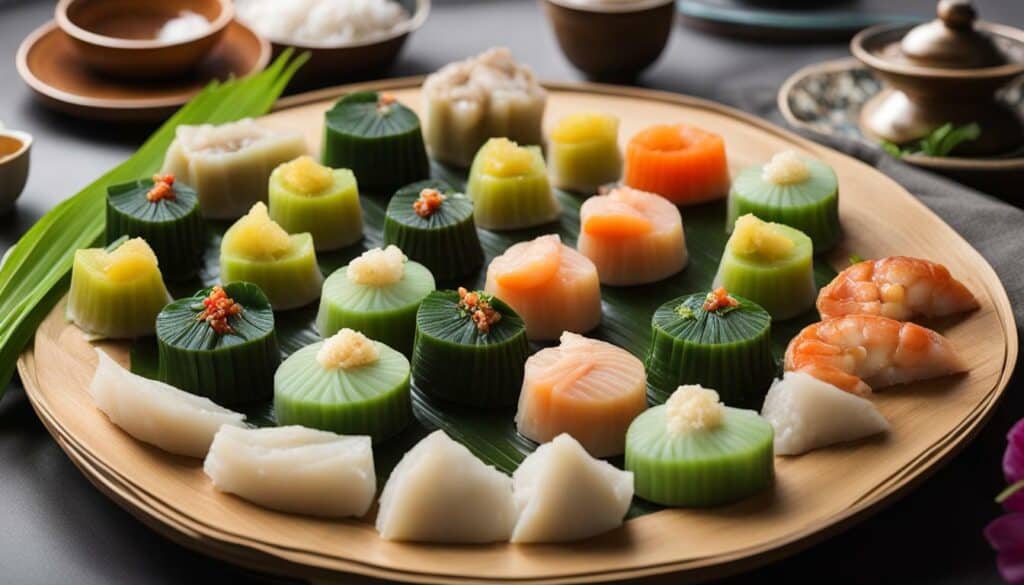
- For a time-saving alternative, you can use premade rice flour dough available at some Asian grocery stores.
- Experiment with different fillings, such as mushrooms, water chestnuts, or even minced meat, to create your own unique variations of Soon Kueh.
- If you prefer a spicier kick, add some finely chopped red chilies or chili paste to the filling mixture.
- Ensure the Soon Kueh are adequately steamed to achieve the desired texture. Oversteaming may cause the dumplings to become soggy, while understeaming may result in a chewy texture.
Unleash Your Inner Chef – Make Soon Kueh Today!
Now that you have all the knowledge and inspiration, it’s time to put on your chef’s hat and create a batch of scrumptious Soon Kueh that will impress everyone around you. Making Teochew steamed dumplings filled with shredded jicama and bamboo shoots may seem daunting at first, but with my guide, you’ll be able to whip up this delightful Asian treat in no time.
To start, let’s gather the necessary ingredients. For the soft and chewy dough, you’ll need a combination of rice flour and tapioca starch. This unique blend gives the Soon Kueh its characteristic texture. For the flavorful filling, gather jicama, carrots, bamboo shoots, dried shrimp, and a variety of seasonings. These ingredients come together to create a burst of flavors that will delight your taste buds.
Once you have everything ready, it’s time to roll up your sleeves and get cooking! Follow my step-by-step instructions for preparing the dough and filling, ensuring that each component is perfectly made. Then, move on to wrapping and steaming the Soon Kueh. This process requires a gentle touch and precision to achieve the ideal texture and shape.
| Serving Tip: | For an extra touch of indulgence, serve your Soon Kueh with a side of sweet dark soy sauce and chili sauce. These condiments elevate the flavors and add a delightful kick to each bite. |
|---|
Once your Soon Kueh is cooked to perfection, it’s time to serve and enjoy! Create a visually appealing platter by arranging the dumplings with precision and garnishing them with fresh herbs. Take a moment to appreciate the harmony of flavors and textures that you have created, savoring each bite as a testament to your culinary skills.
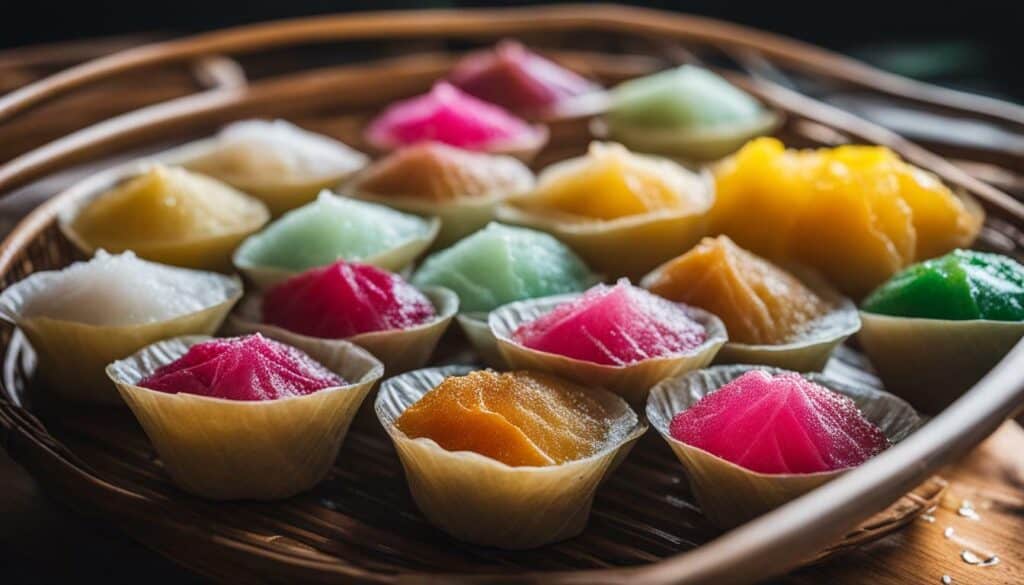
Don’t forget to store any leftovers properly to enjoy later. Soon Kueh can be stored in an airtight container in the refrigerator for a few days. When you’re ready to indulge again, simply reheat the dumplings by steaming them for a few minutes until warmed through. This ensures that every bite is as delicious as the first.
So, what are you waiting for? Unlock your inner chef and embark on this culinary adventure. With my guide by your side, you’ll soon become a master of Soon Kueh, impressing your family and friends with your skills and the delectable flavors you create. Get ready to experience the joy of making this beloved Asian dish in the comfort of your own kitchen!
Embrace the Flavors of Soon Kueh Today!
As you savor the flavors of your homemade Soon Kueh, take a moment to appreciate the cultural heritage and the journey you’ve embarked upon to create this delightful dish. Whip up the delicious Teochew steamed dumplings filled with shredded jicama and bamboo shoots, and let the aromas transport you to the vibrant streets of Asia.
With my step-by-step guide, you’ll learn the secrets to making the perfect Soon Kueh. Start by creating the soft and chewy dough using a combination of rice flour and tapioca starch. This ensures a tender texture that complements the flavorful filling.
The filling, bursting with jicama, carrots, bamboo shoots, dried shrimp, and seasonings, provides the right balance of taste and crunch. Wrap the Soon Kueh parcels skillfully, and steam them until cooked, allowing the flavors to meld together harmoniously.
To enhance your Soon Kueh experience, serve these delectable dumplings with a drizzle of sweet dark soy sauce and a dollop of chili sauce. These sauces add an extra layer of complexity to each bite, elevating your culinary creation to new heights.
Remember, Soon Kueh can be enjoyed at any time, as I provide practical tips on storing and reheating. Indulge in the convenience of savoring these delicacies whenever you desire, as the flavors remain as delightful as the day you made them.
FAQ
Q: What is Soon Kueh?
A: Soon Kueh is a traditional Teochew steamed dumpling filled with shredded jicama and bamboo shoots. It is a popular Asian treat, especially in Peranakan cuisine.
Q: What are the main ingredients for Soon Kueh?
A: The main ingredients for Soon Kueh include rice flour, tapioca starch, jicama, bamboo shoots, dried shrimp, carrots, and various seasonings. These ingredients contribute to the flavorful filling and soft dough.
Q: How do I make the soft and chewy Soon Kueh dough?
A: To make the soft and chewy Soon Kueh dough, you need to combine rice flour and tapioca starch. Follow the step-by-step instructions provided in the article to achieve the perfect texture.
Q: How do I create the flavorful Soon Kueh filling?
A: The flavorful filling for Soon Kueh is made with ingredients such as shredded jicama, bamboo shoots, dried shrimp, carrots, and seasonings. The article provides a tantalizing recipe and instructions for creating a filling bursting with flavor.
Q: How do I wrap and steam the Soon Kueh?
A: The article provides step-by-step instructions for wrapping and steaming the Soon Kueh. Follow these instructions to ensure the dumplings are perfectly cooked and retain their shape.
Q: What sauces can I serve with Soon Kueh?
A: Soon Kueh can be served with sweet dark soy sauce and chili sauce to enhance the flavors. You can also experiment with other complementary sauces and garnishes for a personalized touch.
Q: How do I store and reheat Soon Kueh?
A: The article offers practical advice on storing and reheating Soon Kueh. Follow the tips provided to store the dumplings properly and reheat them to maintain the best taste and texture.
Q: What is the cultural significance of Soon Kueh?
A: Soon Kueh is a Singaporean delicacy and a beloved Asian street food. It holds cultural significance as a traditional Teochew specialty and is enjoyed in local markets and eateries, adding vibrancy to the culinary scene.
Q: Can I make Soon Kueh at home?
A: Absolutely! The article provides a detailed guide on making Soon Kueh at home. Embrace your inner chef and embark on a culinary adventure by following the step-by-step instructions and enjoying the satisfaction of creating this delightful dumpling.
Q: What other traditional delicacies should I explore?
A: There are many other traditional delicacies in Asian cuisine worth exploring. As you continue your culinary journey, consider trying dishes from different regions and cultures to expand your palate and discover new flavors.
Can I Use Your Homemade Candy Recipe to Make Halloween Treats?
Sure, you can definitely use our homemade halloween candy recipes to create delicious treats for the spooky season. Our selection includes a wide range of enticing recipes, from classic caramel apples to spooky gummy worms. Get ready to delight and impress both kids and adults with your homemade Halloween candy creations.

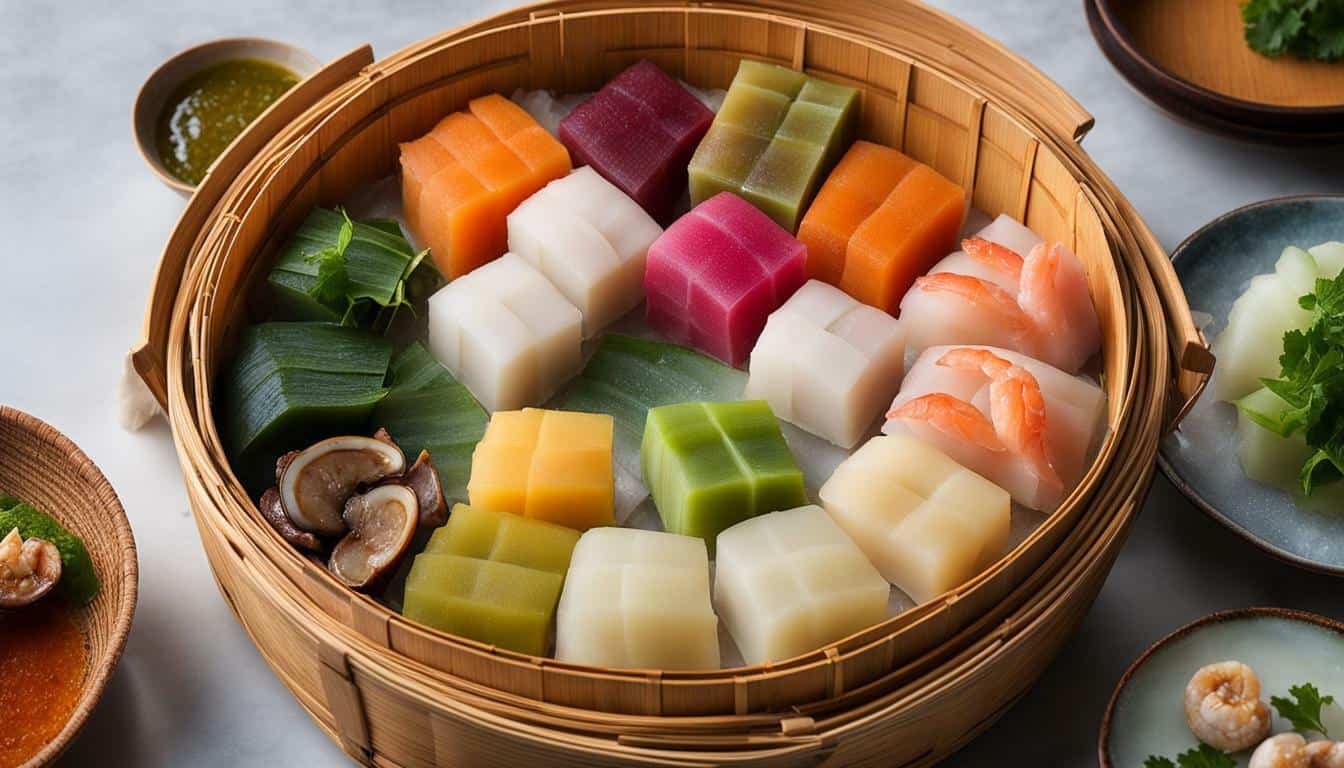
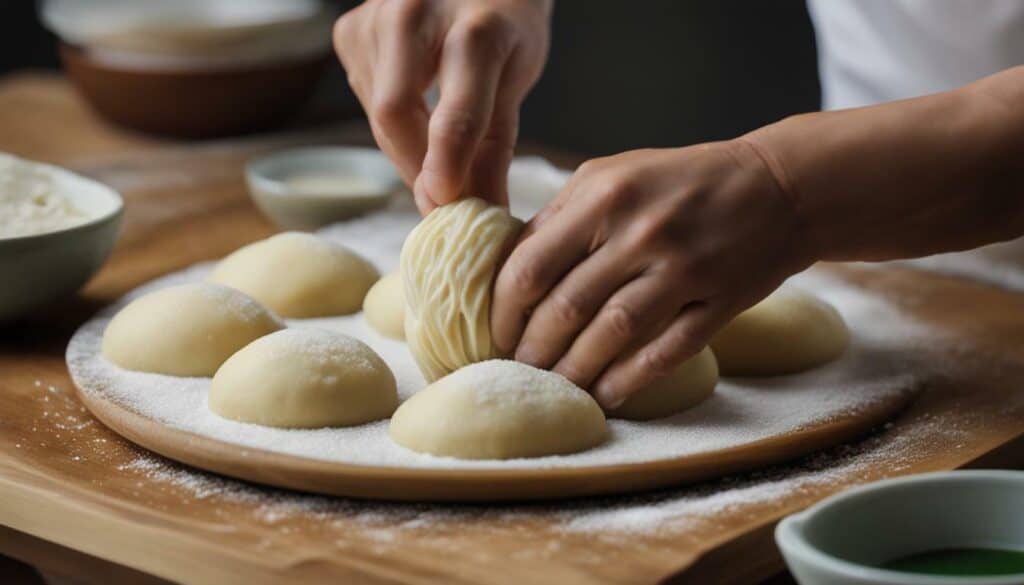
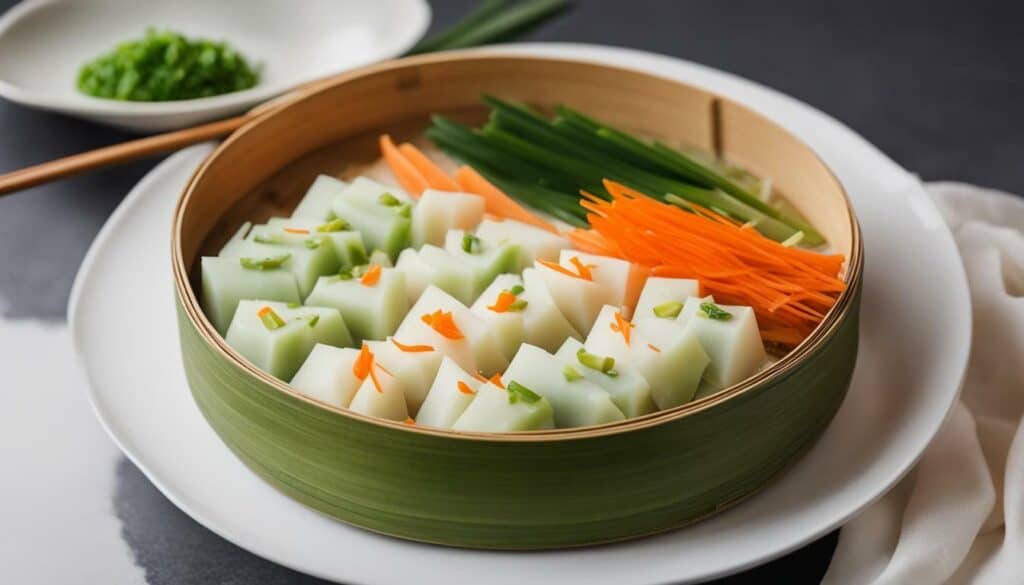
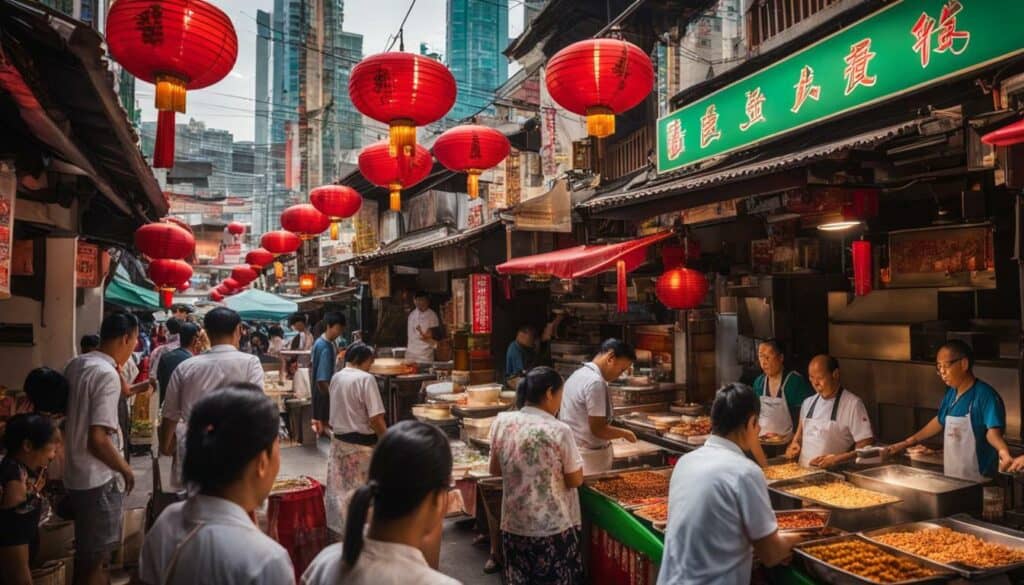



Leave a Reply